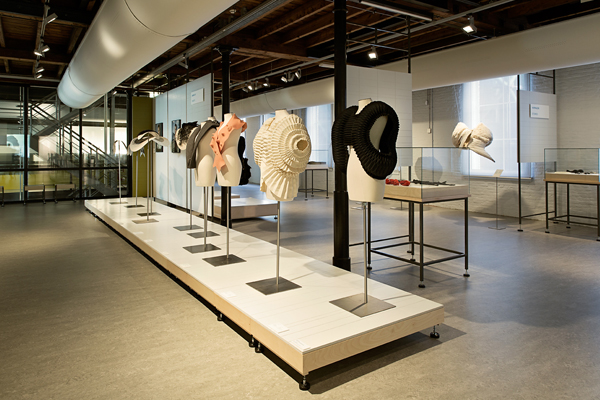
Body Jewels
March 29, 2014–March 15, 2015
TextielMuseum, Tilburg, The Netherlands
Body Jewels
The most direct “body” adornments must be tattoos and piercings. However, one layer up and away from the skin and you are looking at textiles that envelop us from birth to death—swaddle to shroud.
This article looks at the exhibition Body Jewels at the Dutch TextielMuseum. The show documented the interdisciplinary exchanges between textiles and jewelry making in The Netherlands since the 60s. What was the influence of the rebellious, innovative makers of the 60s on contemporary jewelry design, and how did it feed into contemporary practice? This is illustrated in the exhibition by a selection of modern Dutch jewelry from the TextielMuseum’s collection and a number of commissioned works recently produced in the TextielLab.[1] The exhibition provided ample material to study the cross-disciplinary influences between textiles and jewelry, showcased some exciting new pieces, and encouraged visitors to consider the importance of institutional support structures for contemporary practice in The Netherlands.
The Dutch Textile Museum
The TextielMuseum’s stated intent is to showcase on a regular basis a collection of more than 16,000 items ranging from textile design drawings to textile swatches to autonomous art objects. Curator Caroline Boot started the collection of textile art in the 80s. She says: “We are not a jewelry museum but define jewelry as a wearable object on the edge of fine art and design. Since the opening of the TextielLab we have been commissioning artists to make wearable art. Recently commissioned work by Willemijn de Greef and Winde Rienstra is represented in the show. As curator I am interested in work on the cutting edge between art object and wearable piece or—defined in terms of disciplines—between Fine Art, fashion and design. The pieces included in the show illustrate my point.”[2]
For this show, she selected about 100 pieces by 30 Dutch artists out of more than 800 textile-related art pieces. The exhibition was set up in one of the upper rooms of the spacious museum and loosely structured around four themes: “linear play,” “traditional craft,” “the kingdom of beasts,” and “stories.” Before the Dutch textile industry went into decline, the building was a woolen mill, so the exhibiton space retains an open industrial character bathed in great natural light. It has since the 80s morphed from a somewhat staid museum with a display of traditional looms and the all-pervasive delicious smell of raw wool into a well-established hotspot for international designers and artists to experiment and execute work. (The lovely smell of wool lingers and delivers an instant olfactory association to traditional textile production.)
The Riotous Dutch
It is interesting to look at the recent Dutch history of combining jewelry design and textiles. The rapid development of the jewelry discipline in the Lowlands since the 60s mirrored political and societal changes, in particular the Dutch democratic movement. In 1973, the “Legion of Riotous Gold and Silversmiths” was established by Françoise van den Bosch and her colleagues, who strongly opposed and publicly acted against traditional ideas in the arts and in jewelry design.[3] The term “goldsmith” was soon substituted by the much more open term “jewelry designer.” The Legion morphed via several organizational steps and changes of names into the “Association of Jewelry and Free Design” (Beroepsvereniging VES/Vrije Vormgevers) and opened itself to practitioners from other disciplines. In the 1970s, artists with a background in textiles, like Lam de Wolf and Beppe Kessler, joined the jewelry scene. By abandoning the restrictive “goldsmith” label, jewelry designers gained freedom in using any material that suited them.[4] In a small country like The Netherlands, the geographical proximity of these trendsetters supported cross-pollination and a rapid growth of the movement.
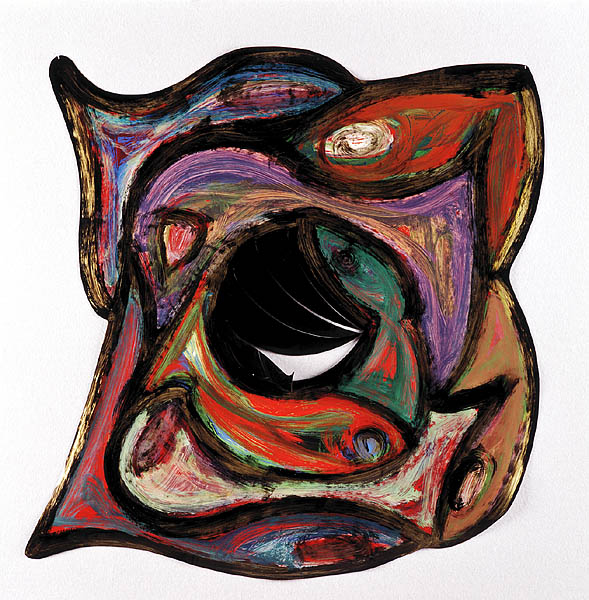
Cross-pollination
In the 70s, prominent jewelry designers like Emmy van Leersum and Gijs Bakker experimented with new materials and concepts. During the same period, textile artists worked to release textiles from the eternal, restrictive concept of the two-dimensional wall hanging. Rietveld Academie professor and master weaver Margot Rolf had dancers performing with her exquisitely woven tubes worn as dresses. Beppe Kessler, Lam de Wolf, Lous Martin, Maria Blaisse, and many of their colleagues were experimenting freely with new materials like rubber and other flexible materials. Textile techniques were appropriated for the manufacture of their wearable jewelry pieces, for example “knitting” in Martin’s wristbands. These knitted “bracelets” can be slid up the arm, changing their color and shape.
Kessler’s work can be characterized as both functional and autonomous. She paints, makes jewelry and has had a long career as a pattern designer. The interaction between these fields plays a clear role in her practice. The ideas for the PVC collars were inspired by her paintings (her current work was on show at Galerie Rob Koudijs in Amsterdam until April 11, 2015). “It is interesting that these grids are derived from the carefully preserved outcome of Kessler’s minimalist explorations from the early eighties. In this way the past connects with the present,” comments Ward Schrijver on the website of the gallery. Kessler has effortlessly combined the design of industrially produced commercial textile patterns with the making of jewelry and fine art.

Look Sideways!
Body Jewels strengthens the argument that textiles and jewelry were—and still are—closely related in the Lowlands. Walk through the exhibition and look sideways, preferably squinting through your eyelashes, and many contemporary pieces find visual references in work from the 60s.
The work of Lam de Wolf, with its linear, larger than (wo)man-sized constructions, finds its mirror image in young fashion designer Winde Rienstra’s Stars in the Firmament body piece. De Wolf gained acclaim with big sculptural wearable pieces that often take the form of outsized grids. The protruding headwear and neck and shoulder objects are made of sticks, textiles, and flexible connecting materials. Wearability is not a priority. The artist’s primary concern is the perception of flexibility and space. She returned to big-scale sculptural pieces in recent years and is represented by Galerie Ra in Amsterdam.
Rienstra’s work was commissioned by the TextielMuseum and produced in the TextielLab. Her fascination lies with an even larger space, i.e the universe and astronomy. For this work, her inspiration was the Eise Eisinga Planetarium in Franeker, The Netherlands, the oldest planetarium still in operation. The brilliance and sparkle of Swarovski crystals in this piece are a translation of the night sky into a wearable body piece.
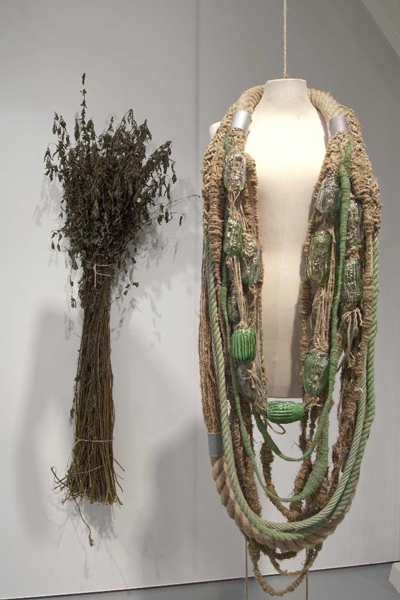
Revival
In the part of the exhibition that is titled “traditional craft,” the revival of craft techniques and the visual links to textile techniques from the 60s is very obvious in the pieces of young jewelry maker Willemijn de Greef. Her work is reminiscent of the technique of macramé, much ridiculed until the iconic Knotted Chair by Marcel Wanders hit the scene. Any connoisseur of textile art will also associate de Greef’s pieces with the huge sculptural rope works of Magdalena Abakanowicz or the woven and braided linen monochrome hangings of American artist Lenore Tawney.
De Greef’s Green Necklace, commissioned by the TextielMuseum, is made entirely from reused and ecofriendly materials. De Greef asked a spinner to handspin ecologically produced hemp yarn into threads. In the TextielLab’s workshop for braiding ropes and elaborate tassels, the threads were twisted together with leftover yarns found in the attic of the museum. The process of twisting different cords together was repeated until the desired thickness was achieved. Finally, de Greef added glass beads, which had been specially blown at the Dutch Nationaal Glasmuseum in Leerdam, to the necklace.
Ever-present Felt
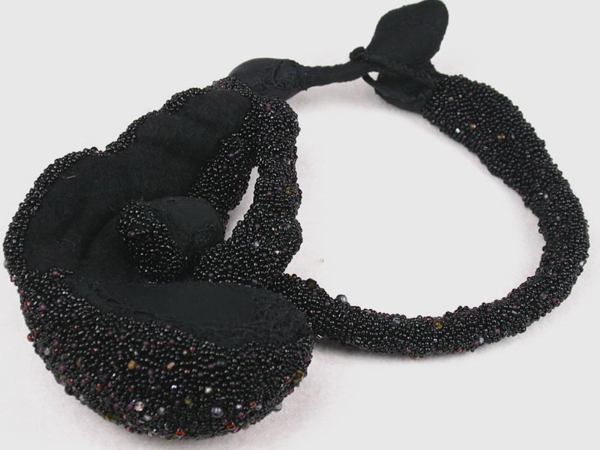 In the textile universe, felt is an evergreen and often underestimated material because of its easy use in amateur workshops and crafty environments. In the fine arts, felt has been the carrier of mystical messages ever since Joseph Beuys’s survival story in World War II went public. Beuys allegedly crashed his German fighter plane in the Caucasian wilderness and was saved by nomads who swaddled him in felt and fat in order to keep him warm and heal his wounds. He visualized his lifelong fascination with felt in huge, mesmerizing installations. Their primal rawness—again with a delicious smell of raw wool and a tsunami of dustmites—was groundbreaking in the 60s. From that point on, felt has never gone out of fashion, and the humble material has been a carrier of new meanings ever since.
In the textile universe, felt is an evergreen and often underestimated material because of its easy use in amateur workshops and crafty environments. In the fine arts, felt has been the carrier of mystical messages ever since Joseph Beuys’s survival story in World War II went public. Beuys allegedly crashed his German fighter plane in the Caucasian wilderness and was saved by nomads who swaddled him in felt and fat in order to keep him warm and heal his wounds. He visualized his lifelong fascination with felt in huge, mesmerizing installations. Their primal rawness—again with a delicious smell of raw wool and a tsunami of dustmites—was groundbreaking in the 60s. From that point on, felt has never gone out of fashion, and the humble material has been a carrier of new meanings ever since.
This same visceral materiality can be found in the works of Brazilian-born artist Célio Braga. He combined felt with glass beads, hair, and cotton in a choker from the series Negros (Black). (This third and final part of a series of works focuses on the human body, in particular on protection rituals related to organs.) Negros refers to death, mourning, and transformation processes. A choker is a short, wide necktie or neckerchief, mostly worn by men.
At the other end of the felt universe, Brigit Daamen uses her own advanced felting techniques in a series of sculptural scarves, which look like industrially manufactured products but are actually made by hand. In another combinations of materials and technique, she made an oversized necklace titled Boa Collier (not included in the exhibition).
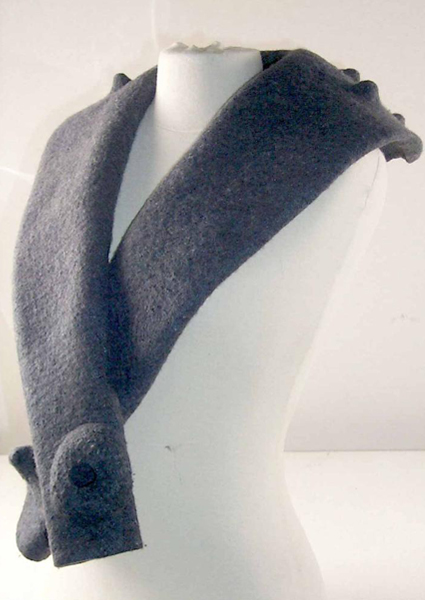
Bridging the Gap—Hybridity
Makers move freely from one discipline, technique, and lab or workshop to the next, using the facilities or exploring new technical territories during artist-in-residencies. Ineke Heerkens and Evert Nijland both used the low-tech facilities of the TextielLab’s braiding workshop in their recent work, and it illustrates how the gap between textiles and jewelry can been bridged. Heerkens started her collection, Shifting Mass, at the European Ceramic Work Centre. During a three-month residency, she explored the potential of using clay and porcelain in jewelry by literally pushing mass, i.e. clay, around with her bare hands. In order to make the ceramic objects and beads into wearable jewelry, she researched the production of unique silk cords in the TextielLab. She ended up with a wealth of material and produced some in a combination of machine-made and handmade Japanese braiding techniques. This hybrid jewelry, a combination of finely braided textile cords in subtle colors with equally sensitively glazed organic shapes, is represented by Galerie Marzee. A special publication, Shifting Mass, describes the making of this body of work.
Nijland has been combining textile materials, techniques, and glass in his work for many years now. The Fragments collection is based on baroque and Renaissance images. Details from paintings, in this case by Hieronymus Bosch, are for Nijland “bearers of light and energy.”[5] The necklace in the TextielMuseum’s collection is made from blown glass; a long cord stretches inside the glass body and via silver pins connects the outer and inner layers of the necklace. In his most recent table pieces, Nijland again includes textile matter into his extravagant voluptuous sculptures.
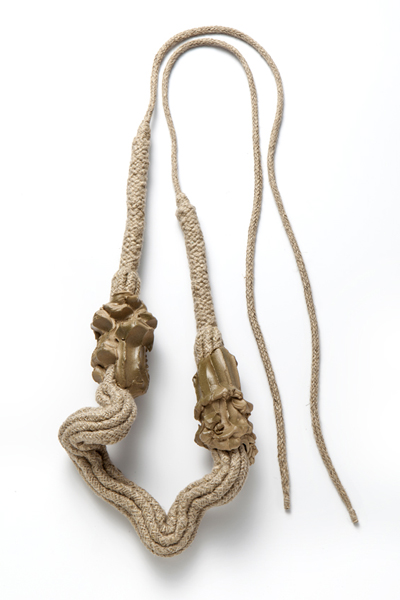 Curator Caroline Boot chose an unusual, surprising point of view in Body Jewels: The open layout of the exhibition encouraged free associations and thoughts about body adornments and jewelry, their wearability, and meaning. Meanwhile, the TextielMuseum’s active commission policy toward jewelry makers, textile designers, and artists alike shows an open-mindedness that evolved out of the rebellious ideas of the 60s.
Curator Caroline Boot chose an unusual, surprising point of view in Body Jewels: The open layout of the exhibition encouraged free associations and thoughts about body adornments and jewelry, their wearability, and meaning. Meanwhile, the TextielMuseum’s active commission policy toward jewelry makers, textile designers, and artists alike shows an open-mindedness that evolved out of the rebellious ideas of the 60s.
The instant availability of information on social media has helped craft institutions like the TextielMuseum, the Leerdam Glasmuseum and workshop, the Sundaymorning@European Ceramic Work Centre, FabLabs, and other workshops establish themselves as the natural habitat of contemporary makers while speeding up cross-pollination and meaningful cooperations. If the ingenuity and perseverance of all makers and institutions have recently been challenged by heavy cuts in financial support for the arts, these in turn have fostered mutual dependence and cooperation: In 2014, a Dutch and Belgium platform of cooperative workshops was established. [6]
In regard to the actual work, the exhibition shows that cross-disciplinarity takes a different path today than it did 50 years ago: The gap between different disciplines like textiles, jewelry, and even glass and ceramics is being closed by the modern “hybrid maker.” In the 60s, jewelry had already been influenced by textile art, supported in The Netherlands by the geographical proximity and political interaction of the artists. Today’s “hybrid makers” evolve their inspiration and techniques by using a worldwide net of open-source information and a network of workshops; they combine new innovative making techniques with traditional craft and any material they favor.
Just outside the museum, once-controversial jewelry pieces in nonprecious materials and textile techniques can be seen in high-street shops: cheap copies of crafted animals or looping scarves echo exquisitely crafted pieces by Felieke van der Leest or Willemijn de Greef. Which ultimately means that the public’s appreciation of nontraditional jewelry has changed and opened up considerably.
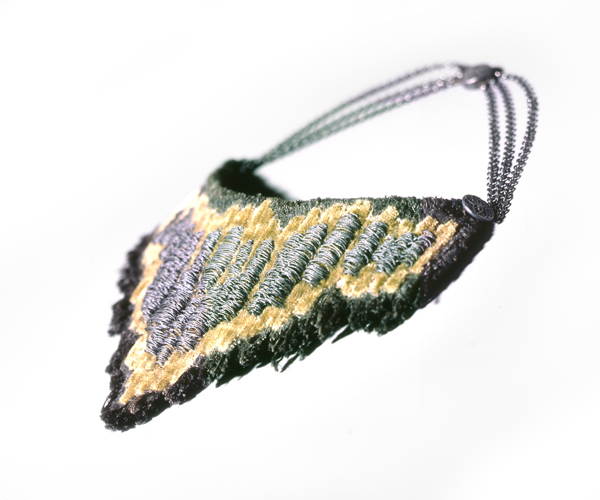
[1] TextielLab is part of the Dutch TextielMuseum and a knowledge center where artists and designers can experiment on CAD/CAM weaving, embroidery, and knitting machines. Product developers and technical experts are assisting clients to discover the endless possibilities of yarns, computer-controlled techniques, and craftsmanship. Some jewelry artists have used the facilities; some have been working on commission for the TextielMuseum.
The TextielLab focuses primarily on design projects (design and fashion) and art. A committee assesses applications on motivation, innovation (technical or material), and artistry.
[2] Caroline Boot, exhibition text.
[3] P. Aarts and R. Huisman, “Sometimes It Seems Like There’s Tension in the Air,” in Mapping Dutch Conceptual Crafts, ed. M. Auch (Amsterdam: BNO, 2008), 20–24.
[4] L. den Besten, “Vrije Vormgeving—Nowhere and Everywhere,” in Mapping Dutch Conceptual Crafts, ed. M. Auch (Amsterdam: BNO, 2008), 76.
[5] Evert Nijland, as quoted on his own website (http://evertnijland.nl)
[6] A second symposium of the cooperative workshops is scheduled for the autumn of 2015. http://topgemaakt.nl/platformwerkplaatsen.html; https://www.facebook.com/platformwerkplaatsen.




